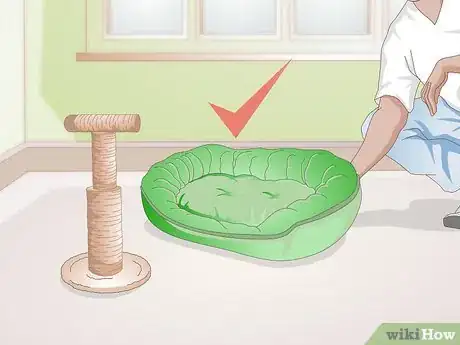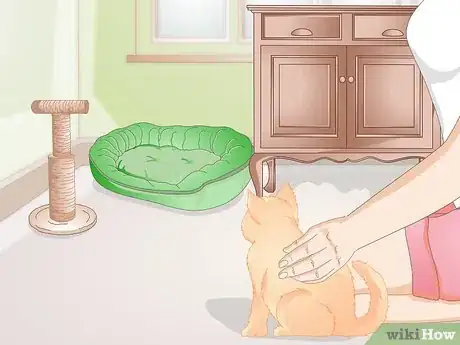This article was co-authored by Brian Bourquin, DVM. Brian Bourquin, better known as “Dr. B” to his clients, is a Veterinarian and the Owner of Boston Veterinary Clinic, a pet health care and veterinary clinic with three locations, South End/Bay Village, the Seaport, and Brookline, Massachusetts. Boston Veterinary Clinic specializes in primary veterinary care, including wellness and preventative care, sick and emergency care, soft-tissue surgery, dentistry. The clinic also provides specialty services in behavior, nutrition, and alternative pain management therapies using acupuncture, and therapeutic laser treatments. Boston Veterinary Clinic is an AAHA (American Animal Hospital Association) accredited hospital and Boston’s first Fear Free Certified Clinic. Brian has over 19 years of veterinary experience and earned his Doctor of Veterinary Medicine from Cornell University.
There are 8 references cited in this article, which can be found at the bottom of the page.
This article has been viewed 41,222 times.
Cats are sweet and loving animals, but they can be nervous around new people. You might want to befriend a new cat who you just adopted or want to befriend a strange cat, like a friend’s cat or a neighborhood stray. When you befriend a new cat you should let the cat come to you and make the cat feel as comfortable as possible.
Steps
Approaching a Strange Cat
-
1Feed the cat. If the strange cat is your friend’s cat, or looks like they have a good home, then you don’t necessarily need to do this. However, if the cat looks like they are a stray, giving them food will help gain their trust. Leave a bowl of dry food near the cat and step far away from them. When the cat is finished eating it, don’t move toward them right away.[1]
-
2Talk to the cat. Without approaching the cat, talk to them quietly and calmly. You can sit at a distance and do this while the cat is eating. If you are visiting the cat and feeding them daily, sit a little closer to the cat each day.[2]Advertisement
-
3Offer your knuckle and let them approach you. You don’t want to scare the cat away by coming toward them and overwhelming them. Stick your knuckle toward the cat. Let it come to you and rub itself against your hand and smell you. Let the cat sniff you and decide if they want to befriend you back.[3]
-
4Stroke the cat. Give the cat a long pet from the top of their head all the way to the end of their tail. Instead of immediately petting the cat again, stop. Wait a few minutes so the cat wants to be pet again. After a few minutes stroke the cat along their body again. Do this two or three times.[4]
-
5Slowly blink at the cat. Once the cat is across the room from you, look at the cat with “soft eyes.” When the cat looks at you, begin a long and slow blink. Keep your eyes shut longer than a normal blink but not too long where it looks like you are falling asleep. If your cat sees you are a friend, they will long bling back at you.[5]
Becoming Friends With Your New Cat
-
1Prepare the litter box for your cat. Choose a room for the litter box. Usually the best place for a litter box is the bathroom. Set up the litter box with one to two inches of litter and place it near the corner if you can.[6] Get your cat an uncovered litter box so they feel comfortable using the litter box instead of having accidents in your home.[7]
-
2Prepare food, water, and toys for your new cat. Before you bring them home, get your cat food, water, and toys. You can find these at any pet store. Get your cat many different types of toys so they have variety. Buy the same type of food the cat is used to if you can.
- Cats often don’t eat very much when they first are brought to a new home.[8]
-
3Give your cat a safe haven. Buy a covered cat bed or make a space for your cat with cardboard. Turn a cardboard box upside down. Cut two “doors” in the box because cats like feeling like they have an escape route. Make sure the box is big enough for the cat to stand, lay, and move in comfortably. Place the cat’s haven where they can see the door to the room from inside the box.
-
4Create raised surfaces for your cat. They need to be able to jump to survey their surroundings. Clear off any items off of shelves that they can break until your cat is comfortable in the house.
- Cats also need to scratch their nails, so place a scratching post or pad in every room.[11]
-
5Make sure your cat’s environment is safe. Treat your new cat like you would a toddler and “cat-proof” your home. Block off any dangerous nooks and crannies where your cat could get stuck. Clear away anything breakable. Make sure to hide any cords that your cat could chew through.[12]
-
6Let your cat come to you. It might be tempting to reach for the cat immediately and try to interact with them, but that could scare the cat. Your cat will likely not be immediately ready to get too close. Wait for the cat to come to you. You can use your hand or a toy, such as a fishing pole toy, to show your cat you are approachable.[13]
- Cats do not necessarily want to be touched. They may just be happy to be in your presence.[14]
-
7Slowly introduce your cat to new rooms. Start your cat off in “their room.” This is the room where their safe haven is. Once your cat seems comfortable in that room, start introducing them to more rooms. If you live in a large house, make sure to let them explore slowly and only a little at a time. You don’t want to overwhelm your cat.[15]
-
8Slowly introduce other family members. You don’t want to overwhelm your new cat with too many people. You can slowly introduce people one-on-one to your new cat. If your cat seems too overwhelmed, stop introducing them to new people and give them space. [16]
Expert Q&A
-
QuestionHow do you know if a cat is unhappy?
 Brian Bourquin, DVMBrian Bourquin, better known as “Dr. B” to his clients, is a Veterinarian and the Owner of Boston Veterinary Clinic, a pet health care and veterinary clinic with three locations, South End/Bay Village, the Seaport, and Brookline, Massachusetts. Boston Veterinary Clinic specializes in primary veterinary care, including wellness and preventative care, sick and emergency care, soft-tissue surgery, dentistry. The clinic also provides specialty services in behavior, nutrition, and alternative pain management therapies using acupuncture, and therapeutic laser treatments. Boston Veterinary Clinic is an AAHA (American Animal Hospital Association) accredited hospital and Boston’s first Fear Free Certified Clinic. Brian has over 19 years of veterinary experience and earned his Doctor of Veterinary Medicine from Cornell University.
Brian Bourquin, DVMBrian Bourquin, better known as “Dr. B” to his clients, is a Veterinarian and the Owner of Boston Veterinary Clinic, a pet health care and veterinary clinic with three locations, South End/Bay Village, the Seaport, and Brookline, Massachusetts. Boston Veterinary Clinic specializes in primary veterinary care, including wellness and preventative care, sick and emergency care, soft-tissue surgery, dentistry. The clinic also provides specialty services in behavior, nutrition, and alternative pain management therapies using acupuncture, and therapeutic laser treatments. Boston Veterinary Clinic is an AAHA (American Animal Hospital Association) accredited hospital and Boston’s first Fear Free Certified Clinic. Brian has over 19 years of veterinary experience and earned his Doctor of Veterinary Medicine from Cornell University.
Veterinarian Be careful if the cat begins whisking their tail back and forth or starts to flatten their ears. That is a sign that they do not want to be touched.
Be careful if the cat begins whisking their tail back and forth or starts to flatten their ears. That is a sign that they do not want to be touched. -
QuestionIs it okay to introduce a cat to children?
 Brian Bourquin, DVMBrian Bourquin, better known as “Dr. B” to his clients, is a Veterinarian and the Owner of Boston Veterinary Clinic, a pet health care and veterinary clinic with three locations, South End/Bay Village, the Seaport, and Brookline, Massachusetts. Boston Veterinary Clinic specializes in primary veterinary care, including wellness and preventative care, sick and emergency care, soft-tissue surgery, dentistry. The clinic also provides specialty services in behavior, nutrition, and alternative pain management therapies using acupuncture, and therapeutic laser treatments. Boston Veterinary Clinic is an AAHA (American Animal Hospital Association) accredited hospital and Boston’s first Fear Free Certified Clinic. Brian has over 19 years of veterinary experience and earned his Doctor of Veterinary Medicine from Cornell University.
Brian Bourquin, DVMBrian Bourquin, better known as “Dr. B” to his clients, is a Veterinarian and the Owner of Boston Veterinary Clinic, a pet health care and veterinary clinic with three locations, South End/Bay Village, the Seaport, and Brookline, Massachusetts. Boston Veterinary Clinic specializes in primary veterinary care, including wellness and preventative care, sick and emergency care, soft-tissue surgery, dentistry. The clinic also provides specialty services in behavior, nutrition, and alternative pain management therapies using acupuncture, and therapeutic laser treatments. Boston Veterinary Clinic is an AAHA (American Animal Hospital Association) accredited hospital and Boston’s first Fear Free Certified Clinic. Brian has over 19 years of veterinary experience and earned his Doctor of Veterinary Medicine from Cornell University.
Veterinarian Be careful introducing your cat to children. Do not let young children around your cat unsupervised if you can avoid it.
Be careful introducing your cat to children. Do not let young children around your cat unsupervised if you can avoid it. -
QuestionHow can I make my cat stop clawing on furniture?
 Brian Bourquin, DVMBrian Bourquin, better known as “Dr. B” to his clients, is a Veterinarian and the Owner of Boston Veterinary Clinic, a pet health care and veterinary clinic with three locations, South End/Bay Village, the Seaport, and Brookline, Massachusetts. Boston Veterinary Clinic specializes in primary veterinary care, including wellness and preventative care, sick and emergency care, soft-tissue surgery, dentistry. The clinic also provides specialty services in behavior, nutrition, and alternative pain management therapies using acupuncture, and therapeutic laser treatments. Boston Veterinary Clinic is an AAHA (American Animal Hospital Association) accredited hospital and Boston’s first Fear Free Certified Clinic. Brian has over 19 years of veterinary experience and earned his Doctor of Veterinary Medicine from Cornell University.
Brian Bourquin, DVMBrian Bourquin, better known as “Dr. B” to his clients, is a Veterinarian and the Owner of Boston Veterinary Clinic, a pet health care and veterinary clinic with three locations, South End/Bay Village, the Seaport, and Brookline, Massachusetts. Boston Veterinary Clinic specializes in primary veterinary care, including wellness and preventative care, sick and emergency care, soft-tissue surgery, dentistry. The clinic also provides specialty services in behavior, nutrition, and alternative pain management therapies using acupuncture, and therapeutic laser treatments. Boston Veterinary Clinic is an AAHA (American Animal Hospital Association) accredited hospital and Boston’s first Fear Free Certified Clinic. Brian has over 19 years of veterinary experience and earned his Doctor of Veterinary Medicine from Cornell University.
Veterinarian So, the first thing that I recommend when my kitten owners come in is to teach them how to trim nails. The cats are not scratching to be destructive. It is the only way to remove the dead husk of the nail. If your cat still needs a scratch, get a scratching post. You can also purchase upholstery types that are cat resistant.
So, the first thing that I recommend when my kitten owners come in is to teach them how to trim nails. The cats are not scratching to be destructive. It is the only way to remove the dead husk of the nail. If your cat still needs a scratch, get a scratching post. You can also purchase upholstery types that are cat resistant.
References
- ↑ https://pethelpful.com/cats/How-to-Gain-a-Stray-Cats-Trust
- ↑ https://pethelpful.com/cats/How-to-Gain-a-Stray-Cats-Trust
- ↑ http://www.huffingtonpost.com/quora/a-step-by-step-guide-to-b_b_7986174.html
- ↑ http://www.huffingtonpost.com/quora/a-step-by-step-guide-to-b_b_7986174.html
- ↑ http://www.huffingtonpost.com/quora/a-step-by-step-guide-to-b_b_7986174.html
- ↑ https://www.petfinder.com/cats/bringing-a-cat-home/bringing-home-new-cat/
- ↑ http://bestfriends.org/resources/bringing-new-cat-home-how-prevent-problems-day-one
- ↑ http://bestfriends.org/resources/bringing-new-cat-home-how-prevent-problems-day-one
- ↑ https://www.petfinder.com/cats/bringing-a-cat-home/bringing-home-new-cat/
- ↑ http://bestfriends.org/resources/bringing-new-cat-home-how-prevent-problems-day-one
- ↑ https://www.petfinder.com/cats/bringing-a-cat-home/bringing-home-new-cat/
- ↑ http://www.catbehaviorassociates.com/tips-for-bringing-home-a-new-cat/
- ↑ http://www.catbehaviorassociates.com/tips-for-bringing-home-a-new-cat/
- ↑ Brian Bourquin, DVM. Cat Behavior Trainer. Expert Interview. 20 December 2019.
- ↑ http://www.catbehaviorassociates.com/tips-for-bringing-home-a-new-cat/
- ↑ http://www.catbehaviorassociates.com/tips-for-bringing-home-a-new-cat/







































































